Châteauneuf-sur-Loire to Orléans

Centre-Val de Loire
2. Châteauneuf-sur-Loire to Orléans
Medium
7h30
28km
+363m
-367m
Step
Embed this item to access it offline
Leaving Châteauneuf-sur-Loire you follow the banks of the Loire for 6,000 metres. A first stop to visit the picturesque alleys of Jargeau on the right bank of the river is a must. Leave the bank to cross the villages of the great suburb of Orléans to stroll along the Orléans canal. Combleux awaits you, this former fishing village has become a very popular place for family walks. The quays of the Loire guide you towards Orléans, a stop in front of the church of Saint-Aignan before entering the narrow streets of the city towards the cathedral with all the heritage that makes the charm of this city.
7 points of interest
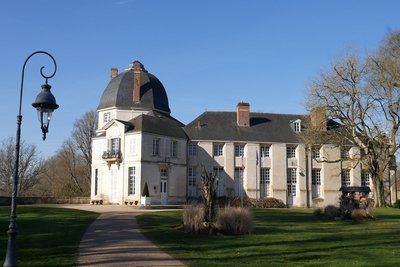
Château de Châteauneuf-sur-Loire - Amis de saint Colomban HistoricalCastle in Châteauneuf-sur-Loire
The origin of Châteauneuf-sur-Loire dates back to the 11th century, the name of the town was given by the "Castrum Novum".
Of the castle of the 17th and 18th centuries, the remarkable rotunda as well as the numerous outbuildings of the castle still remain.
Today, the Town Hall is located inside the castle.
Around it, an English-style park extends over 33 hectares and offers a pleasant and restful setting with trees, most of which are two hundred years old. This natural area now links the botanical park to the Loire River.
Next to the town hall visit the marine museum.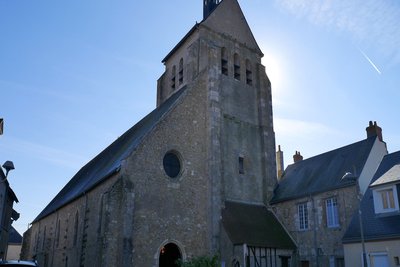
Église Saint-Denis à Saint-Denis-de-L’hôtel - Amis de saint Colomban TouristSaint-Denis Church in Saint-Denis de l'Hôtel
Built on an old building dating from the 12th century, it was destroyed in 1567 by the Calvinist armies of Coligny.
Its reconstruction lasted until 1637, a date engraved in stone above the main door surmounted by a Romanesque arch. The windows are of pointed arch construction, the thick box-trees rest on massive buttresses.
This building, which is 40 metres long and 14 metres wide, has no pillars; the walls alone bear the weight of the "basket-handle" vault made of chestnut wood.
The interior aspect has changed little since the First Empire. The church, as it still appeared in 1905, with above the porch, the symbol of the republican spirit of the time, "propriété communale république française liberté égalité fraternité".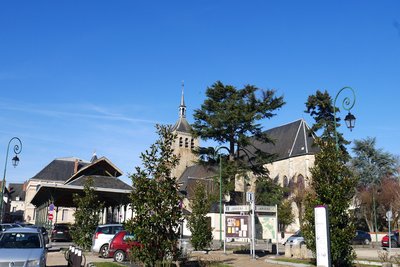
Église Saint-Étienne et halle de Jargeau - Amis de saint Colomban TouristSaint-Étienne Church in Jargeau
The presence of a religious community in the town of Jargeau is attested by many historians as early as the 4th century. No vestiges remain from this period. The church then undergoes, as in all villages on the banks of the Loire, the many invasions of the Normans, causing the disappearance of this community. A new one will settle when the relics of Saint-Vrain were transferred in the 11th century.
The development of the pilgrimage of Saint-Vrain pushes the authorities to build a new place of reception. Thus, in 1154, the choir of a new church was consecrated. The nave and the porch tower were subsequently built. As this church was still not sufficient, a larger choir was rebuilt in the 14th century with an ambulatory and chapels.
The religious wars did not spare the building, which was regularly sacked by Protestants or the king's troops trying to reclaim the city.
Around 1625, the choir of the church was rebuilt on the limits of the old choir but without the ambulatory and the chapels.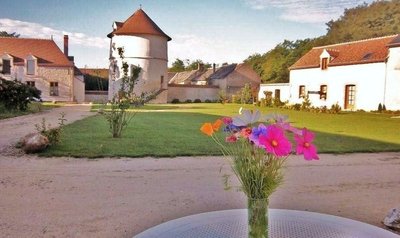
Le Pigeonnier du château de Latigny, Gîte - Image Loiret Tourisme HistoricalLatingy Castle
The lordship of Latingy dates back to the 15th century. It occupies the lands of the Sainte-Croix d'Orléans Abbey. The buildings of the original castle were unfortunately demolished and rebuilt in the 19th century. Part of the buildings of the "barnyard", the castle farm, remain, including a magnificent dovecote probably dating from the early 16th century. It is known that it was a sign of nobility and a privilege to own a dovecote. The one in Latingy is a round tower built over a beautiful vaulted cellar.
The castle is a private property and cannot be visited.
A gîte is available on the site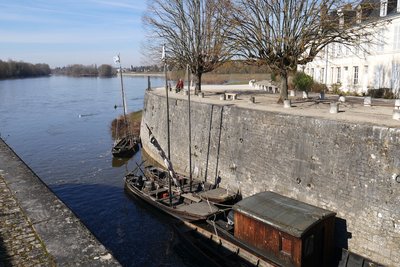
Écluse de Patache, le bief de Combleux sont alimentés par la Loire. - Amis de saint Colomban TouristThe Bief in Combleux
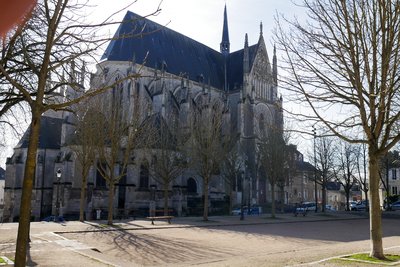
Église Saint-Aignan Orléans - Amis de saint Colomban St ColumbanSaint-Aignan Church - Orléans
Saint Aignan (c. 358 - c. 453), bishop of Orléans, played a great role, at least morally, during the siege of Orléans in 451 by Attila and his troops. Gregory of Tours, a contemporary of Aignan, attests to this. On the death of the bishop, the monastery of Saint-Pierre-aux-Bœufs, located on the banks of the Loire in an old castrum, took the name of Saint-Aignan. The monastery's Saint-Pierre church was the burial place of several Merovingian bishops. Its position outside the ramparts as well as on the banks of the Loire allows us to suppose that the stopover of Colomban and his companions around 610 could have taken place in this monastery. But the Vita Columbani only mentions this stop for the supply of the monks and describes a miracle, Colomban cured the father of a Syrian woman. The city of Orleans was a crossroads of international trade since Roman times and the presence of a Syrian community with camels for towing boats is attested from that time.
The church cannot be visited for security reasons.
The crypt has been altered over the centuries, located under the church of Saint-Aignan and accessible only with a guide. The Saint-Aignan crypt is a beautiful relic from the 11th century. As evidenced by the martyrium and a large ambulatory with five chapels condemned in the 15th century, the building was dedicated to the worship of the relics of Saint-Aignan, patron saint of Orléans.
Semi-buried, this splendid Romanesque crypt preserves rare sculpted and polychrome capitals from the beginning of the 11th century.
In the 7th century, the church was mentioned as a monastery under the mixed rule of the good fathers Benedict and Colomban.
To visit the crypt : Orléans Tourist Office
Cathédrale Sainte-Croix Orléans - Amis de saint Colomban TouristHoly Cross Cathedral in Orléans
The foundation of Orléans Cathedral is the subject of two hagiographical legends in Orléans. Written at different times, they do not feature the same characters and, as a result, also diverge in their purpose.
Until the 7th century, nothing precise is known, neither about the buildings that succeeded one another, nor about their location.
In 989, the city was destroyed by a great fire which, according to Raoul Glaber, also ravaged the cathedral.
Around 1277, the Romanesque cathedral is said to have collapsed and all the walls of the building were unstable. In a deed given on July 22, 1278, Bishop Robert de Courtenay offered the land on which his episcopal palace stood for the expansion of the cathedral. However, work began nine years later, on September 11, 1287, under the episcopate of Gilles Pastai, and the construction began with the chevet.
The plan was inspired by that of Notre-Dame d'Amiens Cathedral, but features nine absidal chapels instead of the seven in the Picardy cathedral. In the 14th century, the chevet is completed by a new choir. The two campaigns of the construction site at the choir of Sainte-Croix are well known thanks to a plan on parchment preserved at the Notre-Dame de Strasbourg work.
More information: Wikipedia
Description
In front of the church of Châteauneuf-sur-Loire you turn right towards Place Aristide Briand, rue Bonne Dame, fourth street on the left, go straight on in the park.
- At the exit of the park turn right, to go around the field, in the direction of the Loire.
- Turn right on the riverside path, first road on the left to stay by the Loire.
- Stay on the bank at the Jargeau bridge, possibility to visit the city by crossing the Loire river.
- After 1,400 metres, turn left and then right.
- At 2 400 meters, take twice on the right the tarred road, direction Latingy, at the castle take on the left, rue de la Chaise, cross the village take on the right at the crossroads, rue du Poutil, then on the left rue de Latingy.
- At the exit of the village turn left, rue de la Tuilerie, straight ahead on tarmac road, at the crossroads turn right, rue des Plantes, then first left along the Orléans canal.
- At the swing bridge turn left and then right to join the bank of the Loire, at Combleux follow the Loire River to the lock to cross and take the path along the canal.
- After passing under the bridge follow the quay and take the fourth street on the right, rue de Saint-Aignan to visit the Saint-Aignan church, then return to the quays of the Loire to take the fourth street on the right, rue de la Poterne, rue Parisie, you arrive at Place Sainte Croix in front of the cathedral.
- Departure : Saint-Martial Church, 12 Rue Migneron, 45110 Châteauneuf-sur-Loire
- Arrival : Holy Cross Cathedral, Place Sainte-Croix, 45 000 Orléans
- Towns crossed : Centre-Val de Loire
Altimetric profile
Transport
Report a problem or an error
If you have found an error on this page or if you have noticed any problems during your hike, please report them to us here:








